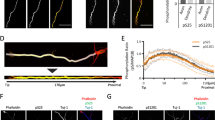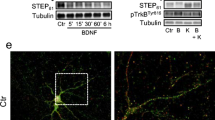Abstract
Object
In neuronal cells, myristoylated alanine-rich C kinase substrate (MARCKS), localized to particular areas of the synaptic membrane, is active during brain development. The destination of phosphorylated MARCKS is thought to be the cytoplasm where it is probably inactive. We compared MARCKS phosphorylation in the brains of embryonic, perinatal, and adult rats to determine its possible involvement in neurogenesis.
Methods
We prepared crude and partially purified extracts from various brain regions of rats aged between embryonic day 14 (E14) and 7 weeks after birth and assayed them for MARCKS phosphorylation by immunochemical methods. The isotypes of protein kinase C (PKC) were immunochemically identified in crude brain extracts from embryonic and postnatal rats. Despite negligible MARCKS phosphorylation, E16 brain extracts contained both MARCKS and PKCγ, δ, ε, and λ. MARCKS and polypeptides were clearly phosphorylated (49 and 45 kDa, respectively) in brain extracts purified on a DE52 column. Embryonic brain extracts manifested a high-molecular-weight activity capable of suppressing polypeptide phosphorylation. This activity was markedly decreased on the day of birth and almost undetectable in the brains of 9-day-old rats.
Conclusions
The embryonic rat brain appears to contain a protein(s) that suppresses the phosphorylation of other proteins including MARCKS. We posit that this inhibitory activity represents a factor(s) that plays a role in the regulation of neurogenesis beginning on the day on which MARCKS appears in the embryonic brain.





Similar content being viewed by others
References
Aderem A (1992)The MARCKS brothers: a family of protein kinase C substrates. Cell 71:713–716
Albert KA, Nairn AC, Greengard P (1987) The 87-kDa protein, a major specific substrate for protein kinase C: purification from bovine brain and characterization. Proc Natl Acad Sci USA 84:7046–7050
Blackshear PJ (1993) The MARCKS family of cellular protein kinase C substrates. J Biol Chem 268:1501–1504
Blackshear PJ, Lai WS, Tuttle JS, Stumpo DJ, Kennington E, Nairn AC, Sulik KK (1996) Developmental expression of MARCKS and protein kinase C in mice in relation to the exencephaly resulting from MARCKS deficiency. Dev Brain Res 96:62–75
Bradford MM (1976) A rapid and sensitive method for the quantitation of microgram quantities of protein utilizing the principle of protein-dye binding. Anal Biochem 72:248–254
Chen J, Chan S, Duncan SA, Okano HJ, Fishell G (1996) Disruption of the MacMARCKS gene prevents cranial neural tube closure and results in anencephaly. Proc Natl Acad Sci USA 93:6275–6279
Clarke PR, Siddhanti SR, Cohe P, Blackshear PJ (1993) Okadaic acid-sensitive protein phosphatases dephosphorylate MARCKS, a major protein kinase C substrate. FEBS Lett 336:37–42
Fujise A, Mizuno M, Ueda Y, Osada S, Hirai S, Takayanagi A, Shimizu N, Owada MK, Nakajima H, Ohno S (1994) Specificity of the high affinity interaction of protein kinase C with a physiological substrate, myristoylated alanine-rich protein kinase C substrate. J Biol Chem 269:31642–31648
Luskin MB (1994) Neuronal cell lineage in the vertebrate central nervous system. FASEB J 8:722–730
Machide M, Kamitori K, Nakamura Y, Kohsaka S (1998) Selective activation of phospholipase Cg1 and distinct protein kinase C subspecies in intracellular signaling by hepatocyte growth factor/scatter factor in primary cultured rat neocortical cells. J Neurochem 71:592–602
Ohmitsu M, Fukunaga K, Yamamoto H, Miyamoto E (1999) Phosphorylation of myristoylated alanine-rich protein kinase C substrate by mitogen-activated protein kinase in cultured rat hippocampal neurons following stimulation of glutamate receptors. J Biol Chem 274:408–417
Palmer RH, Schönwaßer DC, Rahman D, Rappin D, Herget T, Parker T (1996) PRK phosphorylates MARCKS at the PKC sites: serine 152, serine 156, serine 163. FEBS Lett 378:281–285
Pincus DW, Goodman RR, Fraser RAR, Nedergaard M, Goldman SA (1998) Neural stem and progenitor cells: a strategy for gene therapy and brain repair. Neurosurgery 42:858–868
Raff MC (1989) Glial cell diversification in the rat optic nerve. Science 243:1450–1455
Schönwaßer DC, Palmer RH, Herget T, Parker PJ (1996) p42 MAPK phosphorylates 80 kDa MARCKS at Ser-113. FEBS Lett 395:1–5
Seki K, Chen HC, Huang KP (1995) Dephosphorylation of protein kinase C substrates, neurogranin, neuromodulin, and MARCKS, by calcineurin and protein phosphatases 1 and 2A. Arch Biochem Biophys 316:673–679
Stump DJ, Bock CB, Tuttle JS, Blackshear PJ (1995) MARCKS deficiency in mice leads to abnormal brain development and perinatal death. Proc Natl Acad Sci USA 92:944–948
Stump DJ, Eddy RL Jr, Haley LL, Sait S, Shows T, Lai WS, Young WS III, Speer MC, Dehejia A, Polymeropoulos M, Blackshear PJ (1998) Promoter sequence, expression, and fine chromosomal mapping of the human gene (MLP) encoding the MARCKS-like protein: identification of neighboring and linked polymorphic loci for MLP and MACS and use in the evaluation of human neural tube defects. Genomics 49:253–264
Stump DJ, Graff JM, Albert KA, Greengard P, Blackshear PJ (1998) Molecular cloning, characterization and expression of a cDNA encoding the 80–87 kDa myristoylated alanine-rich C kinase substrate (MARCKS), a major cellular substrate for protein kinase C. Proc Natl Acad Sci USA 86:4012–4016
Taniguchi H, Manenti S, Suzuki M, Titani K (1994) Myristoylated alanine-rich C kinase substrate (MARCKS), a major protein kinase C substrate, is an in vivo substrate of proline-directed protein kinase(s). A mass spectroscopic analysis of the post-translational modification. J Biol Chem 269:18299–18302
Walsh CH, Cepko CL (1990) Cell lineage and cell migration in the developing cerebral cortex. Experimentia 46:940–947
Wang J, Arbuzova A, Hangyas-Mihalyne G, McLaughlin S (2001) The effector domain of myristoylated alanine-rich C kinase substrate binds strongly to phosphatidylinositol 4, 5-biphosphate. J Biol Chem 276:5012–5019
Wu M, Chen DF, Sasaoka T, Tonegawa S (1996) Neural tube defects and abnormal brain development in F52-deficient mice. Proc Natl Acad Sci USA 93:2110–2115
Yamamoto H, Arakane F, Ono T, Tashima T, Okumura E, Yamada K, Hisanaga S, Fukunaga H, Kishimoto T, Miyamoto E (1995) Phosphorylation of myristoylated alanine-rich C kinase substrate (MARCKS) by proline-directed protein kinases and its dephosphorylation. J Neurochem 65:802–809
Acknowledgements
We thank Professor Eishichi Miyamoto, Kumamoto University, for his generous gift of anti-serum raised against rat MARCKS, and Ms. Eriko Takado for secretarial and technical assistance.
Author information
Authors and Affiliations
Corresponding author
Rights and permissions
About this article
Cite this article
Hamada, H., Zhang, YL., Kawai, A. et al. Development-associated myristoylated alanine-rich C kinase substrate phosphorylation in rat brain. Childs Nerv Syst 19, 152–158 (2003). https://doi.org/10.1007/s00381-002-0713-x
Received:
Published:
Issue Date:
DOI: https://doi.org/10.1007/s00381-002-0713-x




